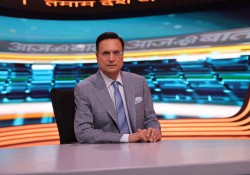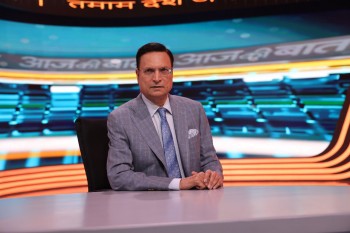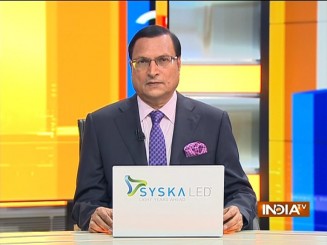
Xi-Putin-Kim Axis : Is Trump baffled?

By displaying its diplomatic, economic and military might, China has directly challenged the United States. With Chinese President Xi Jinping leading the military parade, and 26 world leaders, including Vladimir Putin and Kin Jong-un, watching, the Chinese army displayed its intercontinental ballistic missile capable of carrying nuclear warheads, hypersonic missiles, underwater drones and stealth fighter jets at the Military Day celebrations.
US President Donald Trump wrote on social media: “The big question to be answered is whether or not President Xi of China will mention the massive amount of support and “blood” that the United States of America gave to China in order to help it to secure its FREEDOM from a very unfriendly foreign invader. Many Americans died in China’s quest for Victory and Glory…. May President Xi and the wonderful people of China have a great and lasting day of celebration. Please give my warmest regards to Vladimir Putin, and Kim Jong Un, as you conspire against The United States of America.”
Addressing the parade, Xi Jinping said, China is a great nation that “is never intimidated by any bullies” in an apparent veiled reference to the US, and warned that China is “unstoppable”.
Speaking to media, Donald Trump said, “ … China needs us much more than we need them….We have the strongest military in the world, by far..They would never use their military on us — believe me, that would be the worst thing they could ever do.”
Trump said, he did not see China as a danger, “not at all… America is a big and powerful nation..We are better off economically, and we are now getting money because of tariff. I ended seven wars through dialogue.”
There is no doubt that the US is the world’s biggest military power and a strong economy, but what was the need for Trump to say all this?
Even US experts are worried over the lofty claims being made by Trump. The US President has left diplomatic niceties far behind. He has openly said that Xi Jinping, Putin and Kim Jong Un are “conspiring” against the US.
Such a remark does not behove the US President. What was the need to say that the world cannot run without America? Trump is not alone in making such claims. The North Korean dictator Kim Jong Un also considers his country as a superpower.
Security, Secrets and Concerns of Putin
North Korean ruler Kim Jong-un was the talk of the town at the Chinese military parade. He arrived in his special armoured train ‘Sunshine’ to Beijing railway station. He brought his daughter Kim Ju Ae to watch the parade. The special train with 20 coaches is equipped with anti-tank guided missile, surface-to-air missile and machine guns. The train is protected with armoured plates which can withstand tank shells. It chugged into the station at a speed of 60 km per hour.
Political pundits speculate that Kim is grooming his daughter as his successor, in line with the Kim dynasty. Russian President Vladimir Putin took Kim in his special Aurus car to the bilateral talks venue. He thanked Kim for providing Korean soldiers to fight for Russia in the Ukraine war. Kim’s staff polished all glasses, tables and chairs after the meeting to remove all traces of their leader as a security measure.
It was the second time in two days that Putin invited a foreign leader to sit with him in his car, to avoid his conversation being bugged. On Monday, he had invited Prime Minister Narendra Modi to sit in his car, and on Tuesday, it was Kim Jong-un’s turn to sit in the car. Both the leaders spoke for more than 50 minutes.
Another interesting point: Kim’s staff removed all biological traces from the washroom and toiler that the leader used in Beijing. Putin’s staff did the same when he met Donald Trump in Alaska.
In today’s technological age, presence of physical traces of any leader can be fully analysed to derive health related information. All such traces and evidences are therefore removed after the leader leaves the place.
Floods : Be ready to tackle foodgrain crisis
Punjab, Jammu and Kashmir, Haryana, Uttarakhand, Himachal Pradesh, and now Delhi have been ravaged by flood, cloudbursts and landslides causing death and devastation. Union Agriculture Minister Shivraj Singh Chouhan visited flooded areas of Punjab and met farmers who showed him samples of damaged crops in Gurdaspur. Most of the rivers are in spate and the Yamuna is still flowing above danger level in Delhi. Delhi’s Wazirabad bridge has been closed to traffic.
The Yamuna, in spate, has inundated large areas in Haryana and Mathura in UP. The Yamuna was flowing hardly 600 metres away from the famous Banke Bihari temple in Vrindavan. The entire Parikrama route has been inundated. Flood water has entered most of the ashrams on the bank of Yamuna. Nearly 1,500 people have been shifted to relief camps. Areas near the Taj Mahal in Agra have also been inundated. Flood water has touched the boundary wall of Taj Mahal.
Punjab has been badly ravaged by flood. For the first time since 1988, all the 23 districts of Punjab have been affected by flood in Sutlej, Beas and Ravi rivers. The situation has worsened in Gurdaspur, Fazilka, Hoshiarpur, Kapurthala, Jalandhar, Sangrur, Moga, Barnala, Amritsar and Patiala. Standing crops on roughly 3 lakh acres have been damaged. 324 villages in Gurdaspur and 135 villages in Amritsar are now under water. NDRF, SDRF, army, BSF and Sikh organisations are working round-the-clock in rescue and relief work.
This year’s monsoon has broken all records. Never in the past had Delhi witnessed huge rainfall in the months of August and September. Rains have broken nine-year-old records in Punjab, Himachal and Jammu and Kashmir. Gujarat, Maharashtra and Madhya Pradesh have witnessed one day’s rains equivalent to rainfall recorded during the entire season in past years.
The Centre is trying to provide all possible assistance to the affected states. After the monsoon season is over, one major crisis will be staring in the face.
Foodgrains production may witness a steep decline due to huge loss of crops over several lakh hectares. The government should be ready and must make all preparations to face such an eventuality.
Get connected on Twitter, Instagram & Facebook

Modi, Putin, Xi meeting : Signs of a new world order?

The world’s attention is now focussed on the forthcoming meetings between Prime Minister Narendra Modi, Chinese President Xi Jinping and Russian President Vladimir Putin in the northern Chinese city of Tianjin.
Modi’s meeting with Xi is scheduled for Sunday before he attends the summit of Shanghai Cooperation Organization. This is Modi’s first China visit after seven years.
Already, American and European media have started speculating what will happen if India and China join hands with Russia on the issue of trade. Russian President Vladimir Putin will be visiting India in December and this is surely going to raise tension in Washington DC.
On one hand, we have Trump and his advisers adopting a belligerent approach towards India, and on the other hand, India is engaged in quiet diplomacy. Modi is in Japan which has promised to invest 10 trillion yen in India in the next ten years. Modi hitched a ride with Japanese PM Shigeru Ishiba on the bullet train on Saturday.
Meanwhile China has begun selling US treasury bonds and this has caused a huge pressure on the US government which is facing more than $35 trillion debt. Three top rating agencies including Moody’s and Fitch have lowered US credit ratings.
The Tianjin SCO summit is being seen as China’s major global presentation with leaders from 20 countreis and 10 international organizations going to take part.
China’s semi-official daily Global Times in its editorial has this headline: “China, India strengthening interaction a rational choice in a multipolar world”.
The editorial says, “India’s active participation in the SCO Tianjin Summit reflects its repositioning of the multilateral cooperation framework. …. The current recovery phase of China-India relations is primarily driven by shared strategic needs. Since the Galwan Valley incident, both sides have consumed considerable resources in managing border tensions. Increasingly, both countries recognize that allocating limited resources to economic development and more pressing strategic priorities – rather than endless border disputes – is the more rational choice.”
It is not a secret that Trump’s biggest rival in world trade is China. China has a $650+ billion goods and service trade with the US. This is the reason why Trump, despite wanting badly, could not impose steep tariff on China.
On the other hand, Russia is also the US’ old rival. Despite much efforts, Trump failed to persuade Putin to agree to a ceasefire in Ukraine. Putin is working on his own objectives.
India-US relationship is old, and till a few months back, Trump-Modi ties were good. But due to his belligerence, Trump made his friend Modi his rival. He did not leave any stone unturned in spoling that friendly relationship. Trump deliberately harassed Modi by claiming that he brokered the ceasefire with Pakistan. His effort to bring both Asim Munir and Narendra Modi to a table failed. In the end, he slapped the highest tariff against India.
China was keeping a close watch on this failing relationship. It extended its hand of friendship towards India, and Modi agreed. Putin played a positive role in this. Putin has not forgotten that it was Modi who supported Russia in its worst moments. Despite US pressure, India imported crude oil from Russia.
Now if all these three big countries – India, Russia and China – come together because of Trump’s follies, it is the US President who must be held responsible. The contest is between a loudmouth and silent planners.
Modi is a past master in converting crisis into opportunity. If the SCO Summit ushers in a new world order, it may cause worries for the US.
Abusing Modi’s late mother : Congress, Who is responsible?
The Congress is now on the defensive after some of its workers shouted abusive slogans against PM Modi at a rally in Darbhanga, Bihar. BJP leaders are demanding public apology from Rahul Gandhi. In Patna and Kolkata, BJP and Congress supporters came to blows during protests. They used lathis and threw stones apart from ransacking party offices.
The Congress supporter Mohammed Rizvi alias Raja who has been arrested by Bihar Police from Bhapura Karmauni village, is a driver and runs a tyre puncture shop. Another local Congress leader Mohammed Naushad is under the scanner of police. Naushad had brought some anti-social elements to the meeting and BJP leaders are also demanding his arrest.
The Prime Minister’s late mother was abused by Congressmen, but the party is unwilling to speak on it. Bihar CM Nitish Kumar condemned the incident, while Home Minister Amit Shah, at a rally in Assam, said such an incident happened because Rahul Gandhi has been making objectionable remarks against the PM in most of his meetings in Bihar.
AIMIM chief Asaduddin Owaisi is one of the most trenchant critics of Modi. But it goes to Owaisi’s credit that he never used gutter language against the Prime Minister. There is a clear difference between Owaisi and Rahul Gandhi.
Owaisi is Modi’s political rival, but Rahul Gandhi has deliberately opted for personal enmity towards Modi. If you watch Rahul speaking, he never goes by nuances while criticizing Modi. His remarks are brazen and insulting. He uses phrases like “Sun Modi, “Tu Kya Jaanta Hai”, “Modi Jhootha Hai”, “Modi Chor Hai”, etc.
Rahul Gandhi tries to show off that he is the only politician in the opposition who does not fear Modi and can abuse him. Congress workers and supporters have now taken the cue from their leader. They felt that if they hurl abuses at Modi, Rahul will be happy. Mohammed Rizvi committed this mistake and he is now behind bars. The abuses were hurled from a Congress platform, and yet the Congress says, it is a BJP conspiracy.
Madhya Pradesh chief minister Mohan Yadav was the guest in my show ‘Aap Ki Adalat’ on Friday. He said, “Congress has forgotten Indian culture. In the Mahabharata, Shishupal hurled abuses at Lord Shri Krishna 100 times. When he abused Krishna for the 101th time, the Lord hurled his Sudarshan Chakra and dismembered him. The people of India are now waiting to use their Sudarshan Chakra at the Congress”.
You can watch Aap Ki Adalat with Mohan Yadav on Saturday night at 10 pm on India TV. Repeat telecasts will take place on Sunday at 10 am and 10 pm.
Get connected on Twitter, Instagram & Facebook
Determined India, China’s compulsion : Deal done
 Prime Minister Narendra Modi and Chinese President Xi Jinping on Wednesday put their seal of approval on the agreement between India and China on resuming patrolling near the friction points in eastern Ladakh. The two leaders also decided to resume Special Representative level talks to iron the vexed India-China boundary dispute. These talks have not taken place since 2019, when tension flared up in Dokalam and Ladakh. Both the leaders decided to take relations forward from a “strategic and long-term perspective, enhance strategic communication and explore cooperation to address developmental challenges.”
Prime Minister Narendra Modi and Chinese President Xi Jinping on Wednesday put their seal of approval on the agreement between India and China on resuming patrolling near the friction points in eastern Ladakh. The two leaders also decided to resume Special Representative level talks to iron the vexed India-China boundary dispute. These talks have not taken place since 2019, when tension flared up in Dokalam and Ladakh. Both the leaders decided to take relations forward from a “strategic and long-term perspective, enhance strategic communication and explore cooperation to address developmental challenges.”
The immediate outcome of the bilateral meeting could be that India would soon reopen its doors for Chinese investment, which Xi Jinping needs badly. But the pace of reopening investment shall depend on what happens on the ground in Ladakh and whether Chinese army implements the agreement sincerely. It was also decided in Wednesday’s summit meeting that India and China’s special representatives will discuss resuming Mansarovar pilgrim yatra.
External Affairs Minister S. Jaishankar, National Security Adviser Ajit Doval, Foreign Secretary Vikram Misri and India’s Sherpa at BRICS Dammu Ravi were present with PM Modi at the meeting, while the Chinese President was assisted by Foreign Minister Wang Yi and Chinese Communist Party secretary Cai Qi.
Before the meeting began, Prime Minister Modi said, “mutual respect, mutual trust and mutual sensitivities” were essential for moving forward in bilateral relations. President Xi said, both India and China were two big economic powers and they should present an example of friendship to the rest of the world. Jinping said, both India and China want a multi-polar world and end Western hegemony.
The meeting between Prime Minister Modi and President Xi is an important one and it has ended five years of tense deadlock. One needs to revisit the background in which India-China friendly relations went on a downward spiral because of tension near LAC.
In Dokalam near the Bhutan border, when Chinese troops confronted the Indian army, our brave jawans stood their ground for 72 days and did not allow the Chinese troops to move an inch forward. China again broke mutual trust, when its army ignited tension in Ladakh. It built big infrastructures on its side of the border which posed a security risk for India. India became active on a war footing, built roads, bridges and tunnels near the border at breakneck speed and under PM Modi’s instructions, made mirror deployment of its troops to match Chinese buildup. It was then that the Chinese strategists realized that this was a new India, which was not going to be browbeaten.
In the last three years, Chinese army did not make any big transgression, and instead, sent feelers for resumption of trade and investment, even as talks on reducing border tension was going on. The downslide in investment and trade also affected Indian industrial sectors like electronics, pharma and chemicals, which were dependent on China for procuring raw materials.
Despite facing losses, India stood its ground saying that until and unless there is agreement on the border standoff, talks on other issues cannot be reopened. India did not bow despite economic losses. Ultimately, China understood and Indian diplomacy succeeded.
After several months of talks, China agreed for patrolling deal to be followed by disengagement. By reaching a deal, India and China have told the rest of the world that they were moving forward to normalize relations. Prime Minister Modi’s personal friendship with Russian President Vladimir Putin helped in bringing about agreement.
Though such intervention are never admitted officially, one point is clear: India has told the world that it shall never compromise with its self-respect in any situation. This was underlined by PM Modi at Wednesday’s bilateral, when he said that peace and stability on the border was a top priority for both countries, but, in the next sentence, he said, that “mutual trust, mutual respect and mutual sensibilities” were of essence for improving relations. Modi’s message is clear: India wants good relations with its neighbours, but it will never compromise on the issue of self-respect.